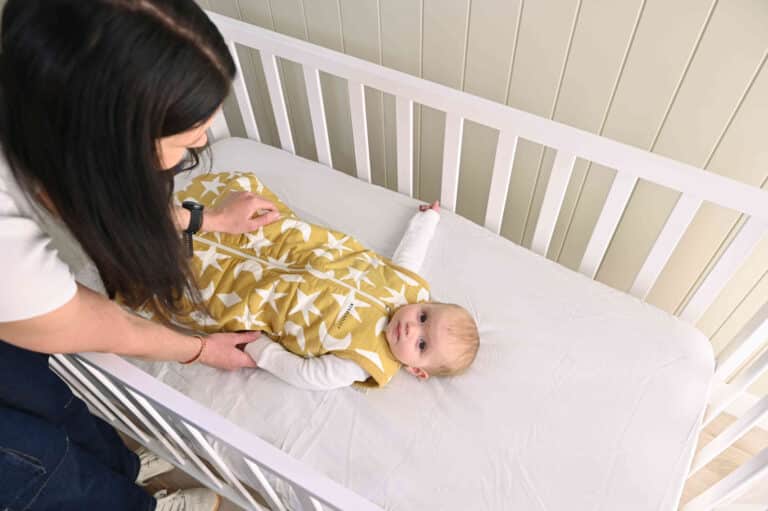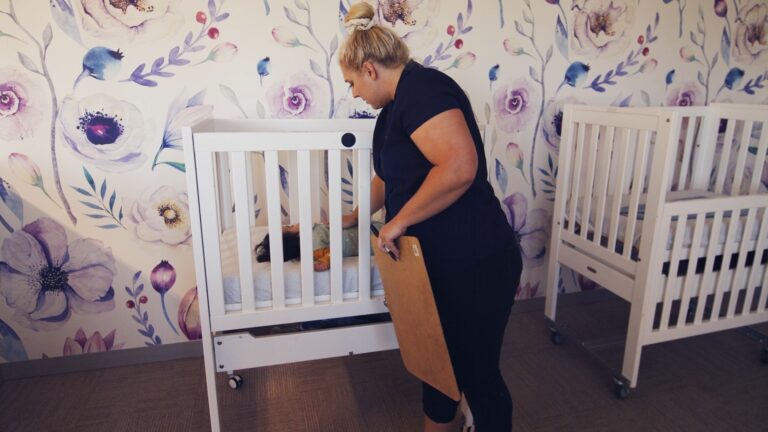Wrapping or swaddling our babies is a gentle way to calm and soothe our babies and is often used as a tool in preparing babies for sleep. It has been shown to help reduce crying time, episodes of waking and has been shown to provide stability, which may help to keep babies in the recommended back position.
There are many different ways you can swaddle or wrap your baby. Recommendations on how to practice wrapping or swaddling can be found here.
What kind of swaddle or wrap is safest?
With the array of sleeping products available, parents are understandably confused and often, overwhelmed with choice.
A wide range of infant care products designed as infant swaddles, infant wraps, and wearable blankets, including products which attempt to combine the features of an infant wrap with an infant sleeping bag, have proliferated on the market and are available to parents. It is important to be aware that there is very limited evidence to support the use of specific products as devices to promote infant settling, back sleeping position and no evidence to support these products as a strategy to reduce the risk of infant death.
Many items use terms such as “swaddle”, “swaddle bag” or “cocoon” and appear to provide the same outcome as a traditional wrap or swaddle – without the fuss, so it is understandable that some parents select these items, believing that they are saving time, effort AND keeping their babies safe.
However, wraps and swaddles are in fact, traditionally, very simple and inexpensive items, often large square pieces of fabric, free or any zips, Velcro or buttons, relying solely on the technique of the parents for correct application.
Red Nose recommends parents and care givers use lightweight wraps such as cotton or muslin (bunny rugs and blankets are not safe alternatives as they may cause overheating). Red Nose does not recommend the use of swaddle bags when baby’s arms are enclosed as an alternative.
When to stop swaddling or wrapping
It is very important to modify the wrapping technique used for your baby as your baby makes developmental changes. Current evidence strongly suggests that as soon as baby shows signs of beginning to roll, or reaches 3 months of age (whichever comes first) wrapping should be ceased for sleep periods.
Principles of Safe Wrapping
- Consider wrapping as a strategy to be used from birth
- Ensure that baby is positioned on the back with the feet at the bottom of the cot
- Ensure that baby is wrapped from below the neck to avoid covering the face.
- Sleep baby with face uncovered (no doonas, pillows, cot bumpers, lambs’ wool or soft toys in the sleeping environment).
- Use only lightweight wraps such as cotton or muslin (bunny rugs and blankets are not safe alternatives as they may cause overheating).
- The wrap should be firm, to prevent loose wrapping becoming loose bedding. However the wrap should not be too tight and must allow for hip and chest wall movement.
- Make sure that baby is not over dressed under the wrap. Use only a nappy and singlet in warmer weather and add a lightweight grow suit in cooler weather.
- Provide a safe sleeping environment (safe cot, safe mattress, safe bedding).
Stop wrapping when baby shows signs of rolling or reaches 3 months of age.
To find out more about how to safely sleep your baby, check out the six safe sleep recommendations.
Did you find this helpful?
Good job! Please give your positive feedback
How could we improve this post? Please Help us.




